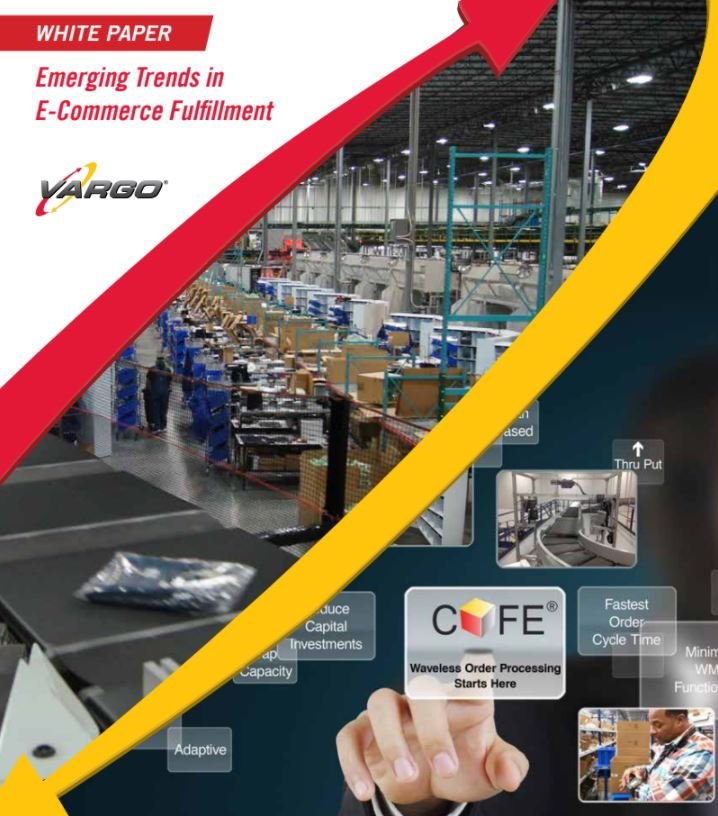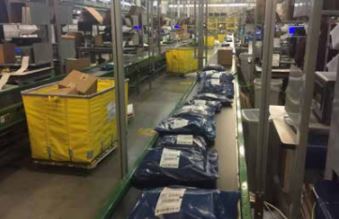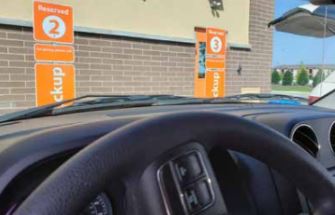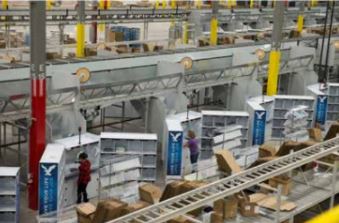
Emerging Trends in E-Commerce Fulfillment
When the coronavirus pandemic hit in early 2020, the e-commerce fulfillment landscape underwent a massive shift in response to spikes in consumer demand, with disruptions to labor, logistics, and product supply. Most of those disruptions were already taking shape prior to the pandemic and were only accelerated by new business restrictions and social distancing protocols.
Today, e-commerce fulfillment requires more advanced systems and technologies to solve for the changes impacting the industry most: overloaded parcel carrier systems, shortage of labor and
increased consumer demand for accurate, fast order delivery.
The overloaded parcel carrier system is driving e-commerce fulfillment operations to take on more of the work previously handled by parcel carriers. Sorting packages for ZIP code zones for regional carriers to transport packages to local markets is now handled by the e-commerce company, not the parcel carrier. Space and labor to handle the additional sort processes are now something that e-commerce fulfillment operators must consider if they are building new or upgrading existing warehouse systems.
Labor — with its high cost and low availability — is another ongoing challenge for e-commerce fulfillment warehouses. Automation is an obvious solution. However, automating the right tasks
and efficiently integrating the technology with the existing warehouse workflow is an ongoing struggle. Automation and any new technology should make fast, accurate decisions that support the fulfillment center’s service-level agreements (SLA) through a synchronized and sequenced workflow, typically driven by a WES (Warehouse Execution System). The significant increase in returns is also having a substantial impact on the labor required to effectively manage inventory. How to considerably reduce labor via automation is a prime consideration when building or retrofitting a facility.
Lastly, inventory positioning to keep the right merchandise closest to the demand source is another new consideration for e-commerce fulfillment facilities and requires growing the number of sites within a network. Combining store inventory, dark stores, warehouses, and other sites to create an integrated fulfillment network continues to be one of the most impactful solutions to decrease overall order cycle time. These types of integrated site networks take time to establish and are strategically placed geographically. Each node/site will maintain a different inventory mix, have different workflows and varying processes for fulfilling orders.
 Adapting to these three factors is driving several key developments in e-commerce fulfillment. Creative solutions are emerging to mitigate the challenges brought by the above-mentioned market forces. Here are four of the most prominent trends in e-commerce fulfillment today.
Adapting to these three factors is driving several key developments in e-commerce fulfillment. Creative solutions are emerging to mitigate the challenges brought by the above-mentioned market forces. Here are four of the most prominent trends in e-commerce fulfillment today.
Trend 1: Implementing Micro-fulfillment Sites
Large distribution centers maintain huge volumes of idle inventory, potentially long distances from the demand source, which increases the inventory carrying costs and transportation expenses. To mitigate those expenses and reduce order cycle time, there is a movement toward operating multiple “micro-fulfillment” sites. The key to undertaking the micro-fulfillment strategy successfully is repositioning inventory across the various sites to accurately meet demand supported by the required transportation resources. Positioning inventory for micro-fulfillment can be done in several ways.
Store fulfillment — In this model, online orders are routed to a local store and processed for pickup or sent out for delivery from the inventory located within the store. Store fulfillment allows labor to be deployed across store purchases and online orders, and it is typically close to the demand. The accuracy of the inventory locator systems can slow down the order cycle time and integrating the point-of-sale with the warehouse system to accurately track orders and inventory can create challenges as well.
 Dark stores — This option is like store fulfillment, but it utilizes closed stores that perhaps did not have enough foot traffic to maintain needed sales per square foot requirements. Operating as a fulfillment center, the dark store offers proximity to demand and labor to support reduced order cycle times, transportation expenses, and inventory carrying costs. Taking over a dark store can be a cost-effective way to expand into a new territory or market, without a long-term commitment and the capital expense associated with a full distribution center build-out.
Dark stores — This option is like store fulfillment, but it utilizes closed stores that perhaps did not have enough foot traffic to maintain needed sales per square foot requirements. Operating as a fulfillment center, the dark store offers proximity to demand and labor to support reduced order cycle times, transportation expenses, and inventory carrying costs. Taking over a dark store can be a cost-effective way to expand into a new territory or market, without a long-term commitment and the capital expense associated with a full distribution center build-out.
Converting a dark store to a micro-fulfillment center does present certain obstacles. The location will only house limited inventory and identifying the correct inventory mix may take some trial and error. Even carrying a small inventory can require a warehouse/fulfillment technology stack, albeit one that is scaled down and customized for the space and merchandise mix. Package storage spaces must be included in the space as well.
Designing and building a system that takes advantage of the existing infrastructure and the smaller scale of the dark store can offer real cost savings and higher returns. A successful deployment
model and execution strategy can be replicated in dark stores globally, allowing for quick and inexpensive expansion opportunities. Dedicated micro-fulfillment centers are often planned as part of the fulfillment process to decentralize fulfillment in densely populated centers. In this model, daily inventory transfers occur based on inventory location. In many ways, they are like dark stores –scaled up in size with on-hand inventory in strategic locations to support consumer demand.
Trend 2: Incorporating Returned Merchandise
Returned merchandise is one of the most labor-intense processing functions within an e-commerce fulfillment operation. Returns typically require human intervention for the initial dispositioning — the complex decision tree of whether an item gets destroyed, restocked, or donated requires manual inspection and special handling. Understanding disposition criteria and criteria for each item per vendor adds another layer of complexity. Lastly, entering the return into an inventory system and noting its disposition is typically another process that can’t be easily automated. Designing a system that makes the disposition process efficient, smooth, and fast requires a high level of customization to account for the warehouse’s specific workflow and space layout. Consumer demand for easy returns, refunds, exchanges must be satisfied, while also minimizing inventory loss and maximizing resale.
Integrators are increasingly focusing on more automation in the initial storage area for returned merchandise. One strategy is equipping the area to handle multiple SKUs and simplifying the “put-
away” task for each SKU. In addition, having multiple locations where each SKU is stored can speed up the put-away task. Some of the technologies used by integrators for multiple SKU setup include pouch sorters, ASRS mini-loads, OPEX® Suresort, Perfect Pick, and Exotec’s AMR base ASRS.
Another strategy for dealing with the increased inflow of returned merchandise is to eliminate returns. Issuing exchange credits or refunds in all cases and defaulting the disposition to the customer to keep or destroy the item in lieu of returning is a strategy that some retailers are adopting.
Trend 3: Integrating with Parcel Carriers
As e-commerce has grown exponentially in the last few years, expectations of delivery times of 48 hours or less have become industry standards. Parcel carriers like FedEx, UPS, and the USPS did not have the capacity to absorb the package spike that happened at the onset of the coronavirus pandemic in early 2020. In fact, their capacity was stretched to its outer limits even prior to the pandemic. This was forcing e-commerce fulfillment centers to bring some parts of the parcel carrier’s process in-house.
Many fulfillment centers have added an automated sort process to the end of the workflow. Sorting packages by size, weight, and ZIP code zone is expected. The best systems go beyond just sorting
and can dynamically match the parcel with the best carrier choice based on the package’s destination, dimensions, and weight. An advanced transportation management system (TMS) has the capability to account for the cost and open capacity of the parcel carriers when making the carrier decision. Some warehouse operators are taking further steps, such as contracting with regional carriers to haul sorted packages to local markets for the final mile delivery by the parcel carriers. Some are building out their own delivery routes and introducing pickup points for customers to shave off the “last mile” from their transportation costs. Tracking parcels through these additional processes while engaging new logistics partners, such as regional carriers and local delivery and ride-sharing companies, requires additional messaging to existing warehouse systems.
 Building in this additional processing capability, formerly handled by parcel carriers, has created an emerging need for increased warehouse space with more agile system connectivity and operational workflows.
Building in this additional processing capability, formerly handled by parcel carriers, has created an emerging need for increased warehouse space with more agile system connectivity and operational workflows.
Trend 4: Automating More Labor
Finding ways to automate simple tasks within the warehouse workflow is perhaps the most prominent trend happening right now in e-commerce fulfillment and the one that is advancing the fastest. The use of robots and artificial intelligence to supplement and/or replace repetitive tasks in the fulfillment operation is at the core of this trend. Robots, machine learning, and AI are being utilized for tasks, such as matching multi-line orders into put walls, on-demand boxes making custom to the size of the order, and the storage and retrieval of inventory.
The robotics industry overall has exploded, with dozens of new vendors in the marketplace, each with a niche set of capabilities. Sourcing robotics solutions for the specific tasks in the warehouse
or re-designing current workflows to include the use of automation is just one of the many design challenges facing e-commerce fulfillment operations. Systematically synchronizing the technologies and sequencing the workflows so that accurate preference is given to the customer SLAs while maximizing the utilization of all the work resources (both labor and equipment) are critical to a successful operation in today’s dynamic environment.
In many cases, the high cost of integrating and maintaining robotics solutions can be a challenge for e-commerce fulfillment operators. A systems integrator can help assess appropriate automation and robotic solutions for specific work functions that may fit the current maintenance resources of the warehouse operator. “Robots as a Service” is a model that has begun to gain ground, where robots are paid for in a “per piece” or “per transaction” arrangement that includes repairs, maintenance, periodic upgrades, and replacement of the equipment. The RaaS model
makes automation affordable because it’s managed as an operational expense and doesn’t go against the traditional capital budget dollars allocated for an operation — warehouse operators can add hundreds of robots to the workflow with virtually no capital outlay. Making this type of automation more affordable has been a game-changer for operators, thus also increasing the overall deployments in the industry. The use of robots and artificial intelligence to supplement and/or replace repetitive tasks in the fulfillment operation is at the core of this trend.
 In summary, these four emerging trends continue to evolve to meet changing demand. To build an e-commerce fulfillment facility that can accommodate growth and truly integrate the ever-changing demands of the consumer, it is critical to have a system with the architecture to pull all these independent workflows together. VARGO® has built dozens of systems that have rapidly adapted to this shifting landscape.
In summary, these four emerging trends continue to evolve to meet changing demand. To build an e-commerce fulfillment facility that can accommodate growth and truly integrate the ever-changing demands of the consumer, it is critical to have a system with the architecture to pull all these independent workflows together. VARGO® has built dozens of systems that have rapidly adapted to this shifting landscape.
About the Author:
VARGO® is an industry leader in both the design and integration of complex material handling solutions and is powered by a team of fulfillment and distribution center specialists with expertise
in warehouse execution systems. For more than five decades, VARGO® has worked with retailers, manufacturers, wholesale, and e-commerce distributors to improve material handling operations
and maximize resource utilization.
Contact VARGO® today to learn how its COFE® WES, the first and most advanced Warehouse Execution System can be the foundation of an integrated warehouse solution that maximizes efficiency, minimizes costs, and scales to future growth. Learn how COFE® can organize and optimize order fulfillment by sequencing and synchronizing workflows in your organization to ensure the most efficient use of all work resources.









